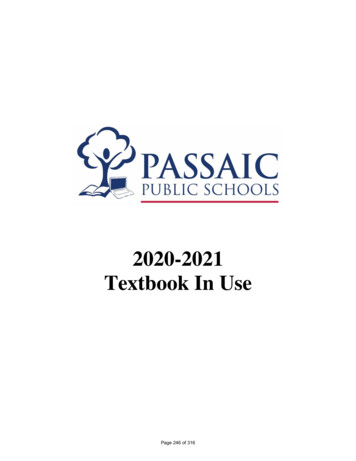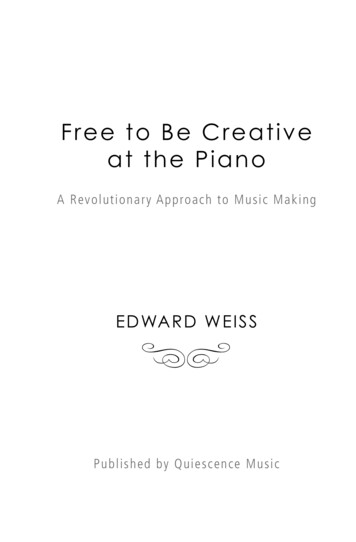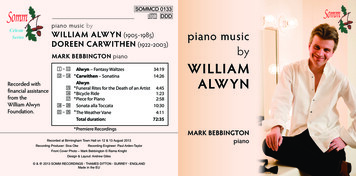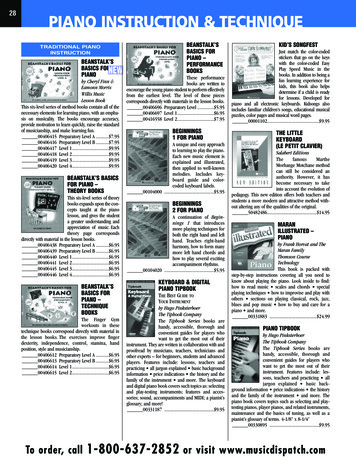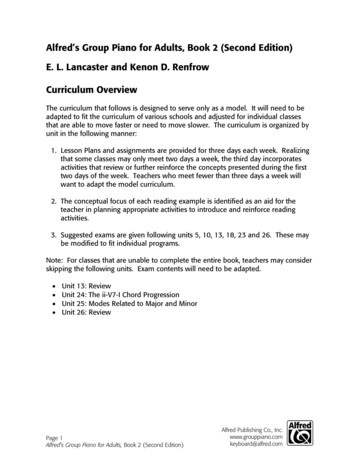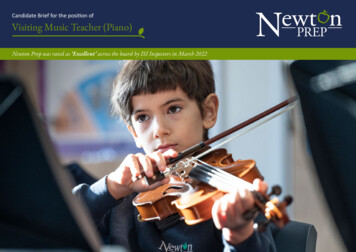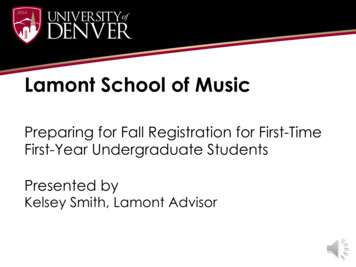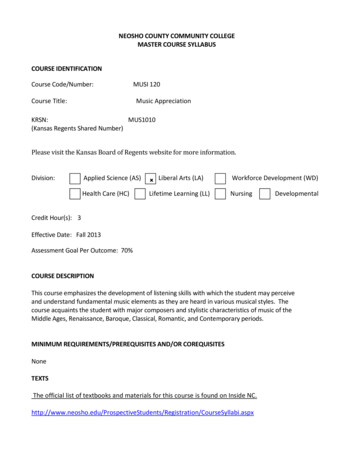
Transcription
PianoGAN Generating Piano Music from Magnitude Matrices(Generative Modeling)Gavin Liujliu66@stanford.eduLaura Fee Schneiderlfee590@stanford.eduSylvia Yuanluyuan@stanford.eduAbstractThe goal of this project is to train a Generative Adversarial Network (GAN) togenerate magnitude arrays, that can be inverted to 20 seconds of harmonic andconsistent classical piano music. We experimented the extension of DCGAN [1],SpecGAN [2], and styleGAN [3] and discovered that adaptation of SpecGANproduces the best output audio clip.1Introduction & MotivationGenerating new music can ultimately be very useful for creators in particular to obtain unlicensedmusic specifically modified for their purpose.The most established models in music generation, like MuseNet, apply language models to symbolicaudio representations like MIDI (musical inference digital inference) files [4]. However, this approachis limited to electronic musical instruments because of its usage of MIDI files. We want to use a moregeneral approach and employ GANs to generate cohesive piano music clips from magnitude matrices,generated from raw audio files.2Related WorksThere exist autoregressive models like SampleRNN, WaveNet and MelNet that use raw audio filesor spectrograms and are very successful on text-to-speech generation tasks [5] [6] [7]. MuseNet isan neural network that can generate music of different instruments and styles [4]. MuseNet usesthe same method used in unsupervised language modeling to predict tokens in MIDI audio file, inorder to generate realistic music audio. The goal of our project is similar to MuseNet. However,our proposed approach is different, as we plan use spectrograms and magnitude matrices from theshort-time Fourier transform (STFT) instead of MIDI files, and do not use language processingmethods.Recent approaches utilizing GANs ( [8], [2], [9]) for generating music with consistent local andglobal features seem the most promising to us. In [2] SpecGAN is introduced which employs theDCGAN algorithm to produce 1 second long instrument sounds. [8] presents GANSynth, a model thatproduces 4 seconds long notes from various instruments, where the generator receives an additionalinput conditioning on pitch labels. The unconditional audio generation GAN from [9] can take avariable-length sequence of noise vectors as input and outputs a mel-spectrogram of variable length.Our approach is an unconditional GAN on a fixed length noise vector that tries to produce notonly single notes but a harmonic melody. This is a very challenging task especially for 10 or 20second long audio clips. To our knowledge, there is no publication about producing such long pianosequences from one graphical representation of raw audio.
3Dataset and PreprocessingFor this project, we work with the MAESTRO dataset [10], which contains over 200 hours of pianomusic. The dataset includes raw audio wav-files and MIDI files of the piano music. We preprocessedthe dataset for training in the following ways: we first divided each wav file into 20 (or 10) secondclips, and used the STFT to convert the audio file into its time-frequency representation. In thenext step, we apply the absolute value to the complex matrix obtained by the STFT to retrieve themagnitude matrix. We decided to use the magnitude matrix without considering the phase values,as our experiments showed that the quality of audio reconstruction was still good when using thelibrosa implementation of the Griffin-Lim algorithm. As suggested in [8], we apply an elementwiselogarithm to the amplitudes. Further, we normalize to zero mean and unit standard deviation. Toobtain values in [-1,1] to match the output of a tanh activation function, we follow the approachin [2] and clip the amplitude spectra to 3 standard deviations and rescale to [-1,1]. With these stepsone can obtain differently large images depending on the sampling rate and the input parameters ofthe STFT algorithm defining the resolution in time and frequency dimension. To train our modelefficiently, we experimented with various parameter settings to see how we can obtain high qualityaudio reconstruction from smaller images.With the default parameters for librosa STFT method (sampling rate 22050, n fft 2048), we acquirearrays of size (1025, 862). To downsample the arrays for computing efficiency when training, wefirst tested the quality of reconstructed audio clips from different downsampled STFT, and decidedthat the sizes (512, 512) and (256, 256) are sufficient for the Griffin-Lim algorithm to reconstructreasonable audio clips of length 20 and 10 seconds respectively. Later, we decided to use a method tofurther reduce loss of quality, by using the parameters sampling rate 10000, n fft 1024, and hoplength 256 for STFT, we acquire arrays of size (513, 782), and downsample the arrays to size (512,512) for training DCGAN with 20 second audio. For the 10 second clips, which we used due to localcomputational restrictions, we choose the sampling rate to be 5500, n fft 512, hop length 128 anddownsample to a size (256, 256) array. Figure 1 presents four examples from our training dataset for10 seconds audio clips.Figure 1: These spectrograms are examples from our training data of 10 second piano sounds.4MethodsOur goal is to find a GAN architecture that can learn to produce such magnitude matrices, whichcan be inverted into piano music sequences. As our baseline model we choose a deep convolutionalgenerative adversarial network (DCGAN). We adapted the general structure of the keras-GANimplementation of DCGAN [1], modified the architecture, and started first trainings.We used the binary cross-entropy loss in python tensorflow.keras library, the loss functions are [11]:J(D) 1mrealXmreali 1mgen1 X(i)· log(D(x )) (1 ygen) · log(1 D(G(z (i) ))).mgen i 1J(i)(G)mgen1 X log(1 D(G(z (i) ))).mgen i 1The generator and discriminator architecture were adapted and modified from the DCGAN architecture in keras-GAN [1], as illustrated in Figure 2. The generator receives a 100 dimensionalinput vector and upsamples to produce a 512 512 dimensional matrix with values in [ 1, 1]. The2
Figure 2: Illustration of the DCGAN baseline architecturediscriminator takes the matrix as an input and returns a single value calculated by a sigmoid activationfunction.Another possibility is to use the architecture of SpecGAN as suggested in [2]. The structure ofgenerator and discriminator is similar to the baseline model. The main difference is the use ofWasserstein loss instead of binary cross-entropy loss. The Wasserstein loss also called Earth Moverdistance can be interpreted as the cost of moving mass in order to transform one distribution intoanother distribution. A Wasserstein GAN (WGAN) as defined in [12] uses the following valuefunction obtained by the Kantorovich-Rubinstein duality,min max E [D(x)] GDx PrE [D(x̂)],x̂ PG(1)where Pr represents the data distribution and PG is the distribution defined by the generator. Forthe WGAN to work we remove all batch normalization layers from generator and discriminatorand do not use any activation function in the discriminator’s output layer. As an additional featurea gradient penalty term is added to ensure that the solution is closer to a 1-Lipschitz function, i.e.a differentiable function with gradients with norm at most 1 everywhere. This penalty term isjustified by a theoretical statement about the optimal solution of the optimization problem in (1), seeProposition 1 in [12], and utilized in the SpecGAN approach as well.The third option we consider is applying the StyleGAN architecture. For StyleGAN2 with adaptivediscriminator augmentation (ADA), we used the library provided by NVIDIA Labs [13]. An adaptivediscriminator augmentation mechanism can significantly stabilize training and prevent discriminatorfrom overfitting or divergence during training, while ensuring the augmentations do not influencethe distribution of generated images. Further, it uses StyleGAN architecture that introduces controlover the style of generated images at different levels of detail. A rough overview of the architectureof this model can be found in Figure 7 in the appendix. We used two data processing and trainingapproaches for this model in order to compare the results.5Experiments/Results/DiscussionTo achieve better results, we conducted three parallel experiments. First experiment is to modifythe architecture of DCGAN [1] and adapt the model to work for (512, 512) magnitude matrices.The second experiment is to adapt the SpecGAN [2] model architecture to our purposes. The thirdexperiment is to convert spectrograms to RGB images and train a styleGAN [3] model to generateimages that can be converted back into spectrograms and audio clips.5.1Extension of DCGANWe modified the model architecture provided in [1] for training with STFT magnitude matrices withsize (512, 512). We chose to use Adam optimizer with a learning rate of 0.0001, β1 0.5, β2 0.9.The intuition for the values of hyperparameters came from specGAN [2]. We decided to use a batchsize of 32 to ensure reasonable updates to the generator parameters.The generator and discriminatorarchitecture was adapted and modified from the DCGAN architecture in keras-GAN[8]. There arevarious ways to improve the power of this generative model and to adjust the architecture to be3
more likely to produce the wanted images. One way is to use various tips and tricks to fine tune andenhance our baseline model. During the training, we encountered several issues with this baselineapproach. We discovered there was a problem with exploding gradient, so we added gradient clippingto the Adam optimizer with clipnorm 1. However, the generated audio was still not close to pianomusic, and the discriminator loss approached 0 while its accuracy approached 1.To weaken the discriminator, we attempted various methods. First is to flip part of real and fakelabels to add noise to the discriminator input [14]. Another approach is to use label smoothing,replacing hard labels of 0 or 1 with soft labels from in the range of 0-0.1 and 0.9-1.0 [15]. We alsoattempted to concatenate generated noise input to the real or fake examples, and generated randomlabels to the real or fake labels, and feed the concatenated inputs to the discriminator.We constantly examined outputs from different adjustments to our models. Figure 3 shows outputsfrom four different failed models, converted to spectrograms for visualization purposes. ThoughFigure 3: Generated outputs from failed DCGAN modelswe were unable to fix the model collapse issue, we believe that likely with more time to fine-tunethe hyperparameters and model architecture, the model will be able to learn to generate reasonablematrices.5.2SpecGAN VersionFor our experiments with the SpecGAN architecture, we used the code provided by [16] and modifiedit for our purpose. We adjusted the code to work with the new tensorflow API and modified it torequire less memory space. Further, SpecGAN used an additional label defining the category ofeach spectrogram. We removed this part from the architecture and changed the generator output anddiscriminator input size to 256 256. The hyper-parameters are the same as in the original SpecGANimplementation, e.g. Adam optimizer with a learning rate of 0.0001, β1 0.5, β2 0.9.The training of the SpecGAN version turned out to be computationally more expensive than thebaseline model and we decided to train it on 10 second audio clips represented by 256 256 matrices.In [2], it is described that training converged after 1750 epochs. Although our dataset is larger andless epochs might be sufficient, the 340 epochs that we were able to train could be too few. It seemsthe GAN is still learning and improving after these epochs. The resulting audio clips sound more andmore like produced by a piano, but do not contain a harmonic melody yet.Figure 4: These spectrograms are produced by the generator of our SpecGAN approach after 340epochs of training.5.3StyleGAN2 VersionWe used two data processing and training approaches in order to compare the results.4
5.3.1Approach 1 - RGB ImagesFor this approach, we normalized STFT matrices generated from 10 second audio clips, resized theminto 256 256, then converted them into RGB images for training. The model achieved the lowestfid50k score of 53.49 (lower the better) after training for 800k images, but modal collapse occurredafter. The generator was not able to generate a variety of images regardless of input.Figure 5: Generated RGB images over 1.4M images trained with the original dimensions (200Kimage difference from left to right)5.3.2Approach 2 - Gray Scale ImagesFor this approach, instead of normalizing the STFT matrices, we scaled up the brightness of importantpixels, then resized them into 512 512 gray scale images for training. Due to time constraint wewere only able to train the model for 400k images. We scaled the brightness of some pixels backdown, and used noisereduce library [17] to reduce white noise in the audio clips.Figure 6: Generated Gray Scale Images (0k, 200k, 400k images trained)6Conclusion/Future WorkJudging from the spectrogram visualization and quality of the audio clips, which can be found inour github repository, we conclude that the best results came form the adaptation of the SpecGANmodel. More training epochs may still be required to achieve better results. However, it seems thatthe model already learned how to reproduce the local features of piano sounds. These sounds are justnot combined to a harmonic melody yet. It is likely that a more evolved architecture is necessary tolearn these global compositions of the piano sounds.In contrast to the methods in [8] and [2], we decided not to transform our magnitude matrices to theMel-scale, because the inversion of our images led to less loss in audio quality. It is possible thattraining with mel-spectrogram could be more effective. However, our results suggest that this shouldnot be a major factor for audio quality.Another aspect that could help produce better audio, is categorize the piano music clips. As statedin [18], adding labels usually improves the results of a GAN. One could use different categories fordifferent types of piano melodies to help the generator learn global harmonic features.7Source Codehttps://github.com/GavinLiu-AI/PianoGAN.git5
8ContributionsGavin Liu:1. Researched on digital audio signal processing and Fourier Transform2. Processed data and generated customized data set from Maestro v3 data set3. Trained networks based on StyleGAN2-ADA-pytorch library using RGB and gray scaleimages4. Worked on image to audio reconstructionLaura Fee Schneider:1. Researched on audio representations and audio reconstruction.2. Contributed to code in preprocessing.py, util.py and pianoGAN SpecGAN version.py3. Trained the SpecGAN version of our model locally on 10 second audio clips.Sylvia Yuan:1. Tested STFT with different parameters and different downsampling parameters/methods tocheck audio reconstruction quality2. Contributed to code in preprocessing.py, util.py and pianoGA dcGAN version.py (modifiedfrom keras-GAN [1])3. Trained the modified DCGAN model with AWS EC2 instanceAAppendixFigure 7 presents a graphical illustration of general idea an architecture of StyleGAN2-ADA, as itcan be found in [3].Figure 7: Illustration of the StyleGAN2-ADA architecture from [3]References[1] E. Linder-Norén, “Keras-gan,” 2017. [Online]. Available: https://github.com/eriklindernoren/Keras-GAN[2] C. Donahue, J. McAuley, and M. Puckette, “Adversarial audio synthesis,” arXiv preprintarXiv:1802.04208, 2018.[3] T. Karras, S. Laine, and T. Aila, “A style-based generator architecture for generative adversarialnetworks,” in Proceedings of the IEEE/CVF Conference on Computer Vision and PatternRecognition, 2019, pp. 4401–4410.[4] A. Topirceanu, G. Barina, and M. Udrescu, “Musenet: Collaboration in the music artistsindustry,” in 2014 European Network Intelligence Conference. IEEE, 2014, pp. 89–94.6
[5] S. Mehri, K. Kumar, I. Gulrajani, R. Kumar, S. Jain, J. Sotelo, A. Courville, and Y. Bengio,“Samplernn: An unconditional end-to-end neural audio generation model,” arXiv preprintarXiv:1612.07837, 2016.[6] A. v. d. Oord, S. Dieleman, H. Zen, K. Simonyan, O. Vinyals, A. Graves, N. Kalchbrenner,A. Senior, and K. Kavukcuoglu, “Wavenet: A generative model for raw audio,” arXiv preprintarXiv:1609.03499, 2016.[7] S. Vasquez and M. Lewis, “Melnet: A generative model for audio in the frequency domain,”arXiv preprint arXiv:1906.01083, 2019.[8] J. Engel, K. K. Agrawal, S. Chen, I. Gulrajani, C. Donahue, and A. Roberts, “Gansynth:Adversarial neural audio synthesis,” arXiv preprint arXiv:1902.08710, 2019.[9] J.-Y. Liu, Y.-H. Chen, Y.-C. Yeh, and Y.-H. Yang, “Unconditional audio generation withgenerative adversarial networks and cycle regularization,” arXiv preprint arXiv:2005.08526,2020.[10] C. Hawthorne, A. Stasyuk, A. Roberts, I. Simon, C.-Z. A. Huang, S. Dieleman, E. Elsen,J. Engel, and D. Eck, “Enabling factorized piano music modeling and generation with themaestro dataset,” arXiv preprint arXiv:1810.12247, 2018.[11] K. Katanforoosh, “Cs230: Lecture 4 attacking networks with adversarial examples[pdfdocument],” 2017. [Online]. Available: 2] I. Gulrajani, F. Ahmed, M. Arjovsky, V. Dumoulin, and A. Courville, “Improved training ofwasserstein gans,” arXiv preprint arXiv:1704.00028, 2017.[13] NVlabs, “Nvlabs/stylegan2-ada.” [Online]. Available: https://github.com/NVlabs/stylegan2-ada[14] S. Chintala, E. Denton, M. Arjovsky, and M. Mathieu, “How to train a gan? tips and tricks tomake gans work,” 2016.[15] T. Salimans, I. Goodfellow, W. Zaremba, V. Cheung, A. Radford, and X. Chen, “Improvedtechniques for training gans,” 2016.[16] N. Tokui, “Specgan,” 2018. [Online]. Available: https://github.com/naotokui/SpecGAN.git[17] “noisereduce.” [Online]. Available: https://pypi.org/project/noisereduce/[18] I. Goodfellow, “Nips 2016 tutorial: Generative adversarial networks,” 12 2016.7
Figure 1: These spectrograms are examples from our training data of 10 second piano sounds. 4 Methods Our goal is to find a GAN architecture that can learn to produce such magnitude matrices, which can be inverted into piano music sequences. As our baseline model we choose a d
